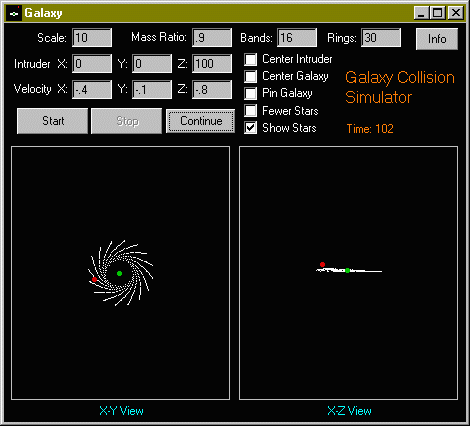
for Visual Basic / Windows
by Terry Newton, December 2001
Just before the moment of impact...

The following is from the zip's readme.txt file...
GALAXY.EXE requires the Microsoft Visual Basic 6 Runtime, specifically the MSVBVM60.DLL file. If the program complains about a DLL being missing, go to your favorite shareware/freeware site and look for the VB6 runtime package.
'GALAXY' is based on QB code from "Galactic Slam Dance" by Douglas E. Music, which was derived from a program presented in the article "Galactic Collisions on Your Computer" by Michael C. Schroeder and Neil F. Comins, published in the December 1988 issue of Astronomy. The QB code was found in the comments of GC3D.C from GC3D.ZIP, see links below.
This program simulates the effects of an intruder mass ripping into a spiral galaxy. It is only an approximation, the stars do not influence each other but rather orbit in the gravitational fields of a central mass and the intruder. The Mass Ratio variable determines the relative mass of the intruder. The Intruder X/Y/Z coordinates specify the initial intruder position, Velocity X/Y/Z components push it in the desired direction. I kept the same split-screen display and coordinate system as original, X axis increases left to right, Y and Z axis increase from bottom to top. The number of stars is controlled by the Rings and Bands variables, maximum 10,000 stars (rings times bands). The more stars the slower it goes. The Scale variable controls overall magnification, increase to magnify, decrease to see more. Scale can be changed while the simulation is running, the other variables are read only when the Start button is clicked to begin a new run.
I made several changes to the calculation code, mostly in the part that calculates the movement of the galaxies. In the original program the position of the main galaxy was fixed, this version calculates the movements of both galaxies. Of course this means usually the galaxy will drift out of view after the encounter, to follow the action check the 'Center Galaxy' or 'Center Intruder' boxes. Check the 'Pin Galaxy' box to make the main galaxy motionless like in the original simulation. To calculate at full speed, uncheck the 'Show Stars' box. If the 'Fewer Stars' box is checked only every 10th star is plotted, increasing speed while providing at least some visual feedback. The checkboxes work when the simulation is running, although checking the pin box after starting is equivalent to thowing on galactic brakes.
Visual Basic source code is in the GALAXY.FRM file. SETPIX.BAS contains a hook to a faster pixel plotting routine, GALAXY.FRX contains the icon, and GALAXY.VBP is the project file.
This is free software. No warantee and all that other stuff like if it fries your computer then tough. To my knowledge VB hasn't fried very many computers and frying is unlikely to result from this code since it contains no file IO at all... but hard drives go bad and cause users to incorrectly blame whatever they were running at the time, and unforseen bugs might lock up the program taking Windows down with it... these things happen so if they do please blame someone else besides me if you must assign blame.
This software was based on public domain QB code and remains public domain.
Related Links:
http://files.seds.org/pub/software/pc/gravity/
galaxy.bas 26-Jun-1992 17:00 6k
gc3d.zip 15-May-1995 17:45 42k
Galaxy.bas is a translation of the original GC3D into another (human) language. Gc3d.zip contains a C version of GC3D with a QB version in the comments, what I based my VB version from.
http://www.atariarchives.org/cfn/05/11/0169.php
ROVAC ZMAGAZINE Issue #170 August 15, 1989
Contains "GALACTIC COLLISIONS ON YOUR COMPUTER"
An adaptation of GC3D for the Atari 8 bit, looks close to the original.
The article gives a lot of insight into the original program, like the
following tidbit:
"The units of the equations used by this program are: one time step equals 1.2 million years, one screen pixel equals 500 parsecs (a parsec is a little more than 3 light years), a mass fraction of 1.0 equals 20 billion solar masses. Everything is big!"
Note.. in my Galaxy version the pixel relationship is true when Scale=TwipsPerPixel, or 15. At the default scale of 10 each pixel would be 750 parsecs (~2300 light years).
http://www.noveltheory.com/Galaxy/Default.htm
An on-line version written in html/VBScript, works only with IE 4.
Equations are viewable in page source.